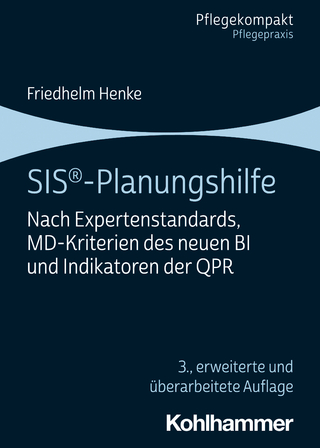
Medical-Surgical Nursing - Single Volume
Saunders (Verlag)
978-1-4160-3641-8 (ISBN)
- Titel ist leider vergriffen;
keine Neuauflage - Artikel merken
Medical-Surgical Nursing: Clinical Management for Positive Outcomes, 8th Edition takes you from basic to advanced medical-surgical nursing with an enhanced multimedia package that makes it easier to learn and apply concepts. This text provides a reliable foundation in anatomy and physiology, pathophysiology, medical management, and nursing care for the full spectrum of adult health conditions. The roles of various healthcare professionals in managing each disorder and are clearly outlined, and evidence-based practice and clinical guidelines are integrated throughout the text.
UNIQUE! Evidence-Based Practice icons identify statements based on primary research or standardized guidelines and teach you to base your practice on solid research evidence.
Translating Evidence into Practice boxes present a topic in the form of a clinical question and summarize the conclusions of 4-5 research articles, encouraging you to judge the research for yourself and consider how it relates to the nursing setting.
Care Plans highlight nursing diagnoses and collaborative problems, expected outcomes, interventions with rationales, and evaluation to help you prioritize tasks and determine the appropriate treatment.
Thinking Critically questions at the end of each nursing care chapter pose short, typical client scenarios followed by questions about what actions to take to test your critical thinking skills.
Concept Maps illustrate the links among pathophysiological processes, clinical manifestations, medical treatment, and nursing interventions.
Integrating Pharmacology boxes help you understand how medications can be used for disease management by exploring common classifications of routinely used medications.
Bridge to Critical Care and Bridge to Home Health Care boxes introduce you to critical care and home health nursing by connecting these related specialties to medical-surgical nursing.
Feature boxes highlight issues in Critical Monitoring, Management and Delegation, Genetics, Terrorism, Community-Based Practice, and Physical Assessment in the Healthy Adult.
UNIQUE! Completely revised and newly illustrated chapter on structural cardiac disorders provides the latest information on the expected outcomes of transplantation and the related nursing care.
UNIQUE! Chapter on management of clients with integumentary disorders includes author Joyce Black's cutting-edge research on pressure ulcers.
Chapter on critical thinking helps you to establish a foundation for high-level nursing care.
Expanded infectious diseases chapter includes vital content on bioterrorism.
Revised health assessment chapter introduces the assessment format used throughout the text.
NIC and NOC labels incorporated throughout in the Nursing Care Plans demonstrate the application of these standardized nursing taxonomies to everyday clinical practice.
UNIQUE! Integrating Diagnostic Studies boxes in every assessment chapter provide examples of laboratory and imaging studies that may be ordered during the course of a client's illness.
Safety Alert icons identify common hospital emergencies and The Joint Commission's patient safety goals and sentinel events to help you keep your patients safe.
Unit I - Foundations of Practice
1.Health Promotion and Disease Prevention
2.Health Assessment
3.Critical Thinking
4.Complementary and Alternative Therapies
Unit II - Health Care Delivery Systems
5.Ambulatory Health Care
6.Acute Health Care
7.Critical Care
8.Home Health Care
9.Long-Term Care
10.Rehabilitation
Unit III - Foundations of Medical-Surgical Nursing
Anatomy and Physiology Review: Body Fluid Compartments and Cellular Function
11.Clients with Fluid Imbalances
12.Clients with Electrolyte Imbalances
13.Acid-Base Balance
14.Clients Having Surgery
Unit IV - Physiologic Foundations
Anatomy and Physiology Review: Physiologic Genomics
15.Perspectives in Genetics
16.Perspectives in Oncology
17.Clients with Cancer
18.Clients with Wounds
19.Perspectives on Infectious Disease and Bioterrorism
Unit V - Psychosocial Foundations
Anatomy and Physiology Review: Arousal, Pain, and Conscious Awareness
20.Clients with Pain
21.Perspectives in Palliative Care
22.Clients with Sleep and Rest Disorders and Fatigue
23.Clients with Psychosocial and Mental Health Concerns
24.Clients with Substance Abuse Disorders
Unit VI - Musculoskeletal Disorders
Anatomy and Physiology Review: The Musculoskeletal System
25.Assessment of the Musculoskeletal System
26.Management of Clients with Musculoskeletal Disorders
27.Management of Clients with Musculoskeletal Trauma or Overuse
Unit VII - Nutritional Disorders
Anatomy and Physiology Review: The Nutritional (Gastrointestinal) System
28.Assessment of Nutrition and the Digestive System
29.Management of Clients with Malnutrition
30.Management of Clients with Ingestive Disorders
31.Management of Clients with Digestive Disorders
Unit VIII - Elimination Disorders
Anatomy and Physiology Review: The Elimination Systems
32.Assessment of Elimination
33.Management of Clients with Intestinal Disorders
34.Management of Clients with Urinary Disorders
35.Management of Clients with Renal Disorders
36.Management of Clients with Renal Failure
Unit IX - Sexuality and Reproductive Disorders
Anatomy and Physiology Review: The Reproductive Systems
37.Assessment of the Reproductive System
38.Management of Men with Reproductive Disorders
39.Management of Women with Reproductive Disorders
40.Management of Clients with Breast Disorders
41.Management of Clients with Sexually Transmitted Infections
Unit X - Metabolic Disorders
Anatomy and Physiology Review: The Metabolic Systems
42.Assessment of the Endocrine and Metabolic Systems
43.Management of Clients with Thyroid and Parathyroid Disorders
44.Management of Clients with Adrenal and Pituitary Disorders
45.Management of Clients with Diabetes Mellitus
46.Management of Clients with Exocrine Pancreatic and Biliary Disorders
47.Management of Clients with Hepatic Disorders
Unit XI - Integumentary Disorders
Anatomy and Physiology Review: The Integumentary System
48.Assessment of the Integumentary System
49.Management of Clients with Integumentary Disorders
50.Management of Clients with Burn Injury
Unit XII - Vascular Disorders
Anatomy and Physiology Review: The Vascular System
51.Assessment of the Vascular System
52.Management of Clients with Hypertensive Disorders
53.Management of Clients with Vascular Disorders
Unit XIII - Cardiac Disorders
Anatomy and Physiology Review: The Heart
54.Assessment of the Cardiac System
55.Management of Clients with Structural Cardiac Disorders
56.Management of Clients with Functional Cardiac Disorders
57.Management of Clients with Dysrhythmias
58.Management of Clients with Myocardial Infarction
Unit XIV - Oxygenation Disorders
Anatomy and Physiology Review: The Respiratory System
59.Assessment of the Respiratory System
60.Management of Clients with Upper Airway Disorders
61.Management of Clients with Lower Airway Disorders
62.Management of Clients with Parenchymal and Pleural Disorders
63.Management of Clients with Acute Pulmonary Disorders
Unit XV - Sensory Impairments
Anatomy and Physiology Review: The Eyes and Ears
64.Assessment of the Eyes and Ears
65.Management of Clients with Visual Disorders
66.Management of Clients with Hearing and Balance Disorders
Unit XVI - Cognitive and Perceptual Disorders
Anatomy and Physiology Review: The Neurologic System
67.Assessment of the Neurologic System
68.Management of Comatose or Confused Clients
69.Management of Clients with Cerebral Disorders
70.Management of Clients with Stroke
71.Management of Clients with Peripheral Nervous System Disorders
72.Management of Clients with Degenerative Neurologic Disorders
73.Management of Clients with Neurologic Trauma
Unit XVII - Protective Disorders
Anatomy and Physiology Review: The Hematopoietic System
74.Assessment of the Hematopoietic System
75.Management of Clients with Hematologic Disorders
76.Management of Clients with Immune Disorders
77.Management of Clients with Rheumatic Disorders
78.Management of Clients with Acquired Immunodeficiency Syndrome
79.Management of Clients with Leukemia and Lymphoma
Unit XVIII - Multisystem Disorders
80.Management of Clients Requiring Transplantation
81.Management of Clients with Shock and Multisystem Disorders
82.Management of Clients in the Emergency Department
| Erscheint lt. Verlag | 28.3.2008 |
|---|---|
| Verlagsort | Philadelphia |
| Sprache | englisch |
| Maße | 216 x 276 mm |
| Themenwelt | Medizin / Pharmazie ► Pflege |
| ISBN-10 | 1-4160-3641-5 / 1416036415 |
| ISBN-13 | 978-1-4160-3641-8 / 9781416036418 |
| Zustand | Neuware |
| Haben Sie eine Frage zum Produkt? |
aus dem Bereich


